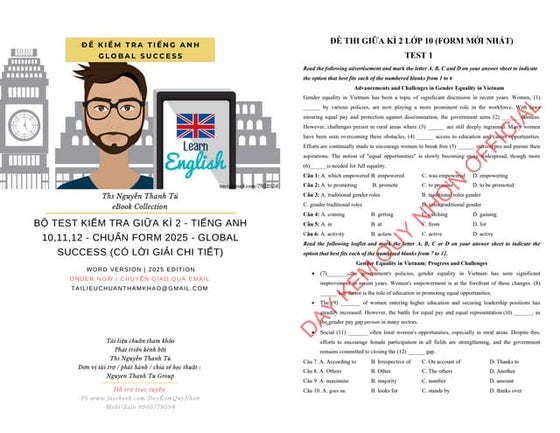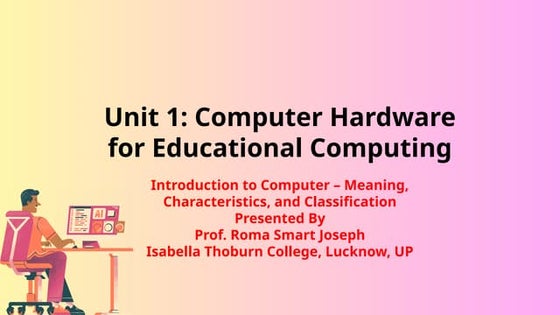Keletso Mabelane University of Johannesburg B ed education FET and senior phase
Download as PPTX, PDF0 likes21 views
An aspiring pedagogical practitioner. Currently studying at the University of Johannesburg in the faculty of education.
1 of 11
Download to read offline











Recommended
DIGITAL MALAYSIAN TRADITION GAME: A CASE STUDY OF BALING TIN



DIGITAL MALAYSIAN TRADITION GAME: A CASE STUDY OF BALING TINijma
╠²
Baling Tin is one of MalaysiaŌĆÖs popular traditional childrenŌĆÖs games. However, as time passes, Baling Tin
has practically almost vanished. Children nowadays are more interested on digital games. This study aims
to preserve the traditional games by digitalising it in tandem with the current interest. The challenge in this
study is to re-create the physical game play into a digital game play. The game application which was
developed for primary and middle school childrenalso includes interactive 3-D objects, images, sounds,
and suitable theme colours.Furthermore, the user can explore many other captivating pages, including
Shop and Quest. Even though the game was designed for Malaysian community, it comes with dual
language to enhance user preference. The functionality of the game mechanics was tested. The game fulfils
game characteristics and imitate the traditional physical gaming.This application is believed to help
younger generations become more familiar with one of MalaysiaŌĆÖs traditional games, Baling Tin, and
preserve traditional games.
Digital Malaysian Tradition Game: A Case Study of Baling Tin



Digital Malaysian Tradition Game: A Case Study of Baling Tinijma
╠²
Baling Tin is one of MalaysiaŌĆÖs popular traditional childrenŌĆÖs games. However, as time passes, Baling Tin has practically almost vanished. Children nowadays are more interested on digital games. This study aims to preserve the traditional games by digitalising it in tandem with the current interest. The challenge in this study is to re-create the physical game play into a digital game play. The game application which was developed for primary and middle school childrenalso includes interactive 3-D objects, images, sounds, and suitable theme colours.Furthermore, the user can explore many other captivating pages, including Shop and Quest. Even though the game was designed for Malaysian community, it comes with dual language to enhance user preference. The functionality of the game mechanics was tested. The game fulfils game characteristics and imitate the traditional physical gaming.This application is believed to help younger generations become more familiar with one of MalaysiaŌĆÖs traditional games, Baling Tin, and preserve traditional games.127



127departamentoefcaura
╠²
The document provides information about traditional games and sports. It discusses how traditional games are an important part of cultural heritage and have educational benefits. Traditional games help develop physical and coordination skills while also fostering collaboration, participation, and attitudes of solidarity and cooperation. The document also outlines objectives, topics, tasks, and evaluations for a 4th year secondary education unit on traditional games and sports.Street and backyard games



Street and backyard gameskatyciai1
╠²
Outdoor and street games have changed over the decades due to shifts in technology, culture, and lifestyle. Some traditional games like hopscotch, tag, and jump rope remain popular across generations, while activities have become more structured and indoor with the rise of digital devices. Descriptions of several traditional outdoor games from different countries are provided, highlighting skills developed through physical activity, teamwork, and fun outdoor play.D0333018020



D0333018020theijes
╠²
This document summarizes a paper that examines improving the traditional Ncho game in Anambra State, Nigeria. It provides background on Ncho, describing it as a popular traditional board game. It then discusses challenges facing the game, such as a lack of inclusion in school curriculum and poor funding. Finally, it proposes recommendations to address these challenges, like incorporating Ncho into physical education classes and providing better facilities and support for the game. The overall aim is to promote Ncho as a means of fostering peace and unity.A14-Seasonal Traditional Games That May be Played in Only a Particular Time o...



A14-Seasonal Traditional Games That May be Played in Only a Particular Time o...Vasilica Gazdac
╠²
This document discusses the game of bowls and its benefits. It is a game that can be played by all ages and abilities to promote inclusion. Bowls helps develop social, coordination, concentration and relational skills through teamwork and strategy. It is a low-cost, accessible activity that provides physical and mental benefits for players of all generations.A14 SEASONAL GAMES-ITALY



A14 SEASONAL GAMES-ITALYHavva Geylan
╠²
This document discusses the game of bowls and its benefits. It is a game that can be played by all ages and abilities to promote inclusion. Bowls helps develop social, coordination, concentration and relational skills through teamwork and strategy. It is a low-cost, accessible activity that provides physical and mental benefits for players of all generations.KEC Board Games



KEC Board GamesKEC
╠²
Board games have existed for over 2000 years, evolving to engage players mentally and socially over generations. This document highlights 8 traditional board games from around the world that promote skills like problem solving, strategy, focus, and sportsmanship. Games described include Tsoh-roh-Yeh-mah-tah- too from Zimbabwe, Picaria from New Mexico, Shisima from Kenya, Bagh Chal from Nepal, KIPEPEOE from Mozambique, Chauka Bara from India, Morabaraba from Africa, and Quirkat of Egyptian origin. Contact information is provided to learn more.traditional games



traditional gamesMrope Sady
╠²
Traditional games are games that have been played for many years within a society and hold cultural significance. They typically have few informal rules, use simple skills and equipment, and involve participants testing themselves rather than competition. Traditional games help pass on cultural values between generations and reinforce community bonds. They can involve physical skill, strategy, chance, memory, rhythm, simulation, or verbal abilities. Traditional games differ from modern sports in having informal local organization, few oral rules, gender-specific play, undefined boundaries, common equipment, and emphasis on the process rather than results.Within the game



Within the gameMauro Andre
╠²
The current study discusses games within physical education programs as an important tool to promote life skills development (E.g. Communication, cooperation). Through a literature review, a review of historical events and life experiences, an ethnography was done in order to provide a better understanding of the major advantages and difficulties while conducting such approach.
The research analyzed its content based on the concept that games offer a common language that allows the communication among different people regardless their origin, culture, race or history (Freire, 2005). The ping pong tournament that allowed Americans into the Chinese territory in 1971 which was subsequently known as ŌĆ£the ping pong democracyŌĆØ is a good example to illustrate this point of view.
Sport history is also discussed to provide a context to better understand the potential negative impact of games when competiveness is taken to the extreme. This seems contradictory to Physical Education as an Educational discipline whereby it plays a role to encourage students to think about their own attitudes while engaged in physical activities. For example, the development of life skills through games can be viewed through such an educational lens. Life skills can be viewed along a continuum from an introspective perspective that focuses on self esteem to the promotion of communication and democracy among peers. This presentation discusses the constraints placed upon games and the tension that often exists from an educational perspective of the role that they play within Physical Education to foster the healthy development of groups and individuals. Folk games and toys around Europe



Folk games and toys around Europekatyciai1
╠²
I went to the pepper field to pick a pepper and the pepper field was locked
╬ł╬Į╬▒ ╬║╬▒Žü╬¼╬▓╬╣ Žå╬┐ŽüŽäŽē╬╝╬Ł╬Į╬┐ ╬╝╬Ą ╬║╬▒ŽüŽŹ╬┤╬╣╬▒
╬łŽåŽģ╬│╬Ą ╬▒ŽĆŽī Žä╬Ę ╬Ż╬▒╬ĮŽä╬┐Žü╬»╬Į╬Ę
╬Ü╬▒╬╣ ŽĆ╬«╬│╬Ą ŽāŽä╬Ę╬Į ╬æ╬╝╬ĄŽü╬╣╬║╬«
╬Ü╬▒╬╣ Žī╬╗╬▒ Žä╬▒ ╬║╬▒ŽüŽŹ╬┤╬╣╬▒ Žä╬▒ ŽĆ╬┐ŽŹ╬╗╬ĘŽā╬ĄLARO NG LAHI PT 1 TAIB.pdf



LARO NG LAHI PT 1 TAIB.pdfEsmaellahTaib
╠²
This document discusses traditional Filipino games or "Laro ng Lahi". It provides descriptions of several traditional games including Langit Lupa, Luksong Tinik, Agawan Base, and Maro. These games help promote health, social skills, cooperation and Filipino culture. The Magna Kultura Foundation works to revive these traditional games in the Philippines so current and future generations can enjoy them.127sol



127soldepartamentoefcaura
╠²
The document discusses the definitions and characteristics of games, sports, and traditional games. It notes that games can involve physical activity, intellectual challenges, or be competitive or non-competitive. Sports are more organized and complex than traditional games, which are typically passed down through generations and reflect local cultures. Traditional games usually have easy rules, are fun rather than competitive, and help develop skills without needing special training. The document provides examples of different types of traditional games classified by characteristics like being competitive, skilled-based, or symbolic.Electronic Sports or E-Sports also called as E-Games



Electronic Sports or E-Sports also called as E-GamesFarhanHjamil
╠²
Hadjijamil and Bryan Bachiller will host today's e-sports event. Hadjijamil is a top MLBB and COD player in the Philippines, while Bryan Bachiller is a legendary Fortnite and COD player. E-sports, also known as electronic sports, refers to competitive video gaming where players compete in organized tournaments. The history of e-sports dates back to the 1970s, but organized tournaments began emerging in the 1990s. The first e-sports tournament was held at Stanford University in 1972. E-sports typically involve gaming equipment like consoles, PCs, and peripherals. Players compete individually or in teams in games like MOBAs, FPS, battle royale,Ethnographic Video Games



Ethnographic Video GamesLorina Navarro
╠²
Presentation delivered at the 2014 Ugnayang Pang-Agham Tao Conference in Baguio City, Philippines. For notes, questions or comments, email me at navarro.lorina@gmail.comCreating new games for physical education classes



Creating new games for physical education classesMauro Andre
╠²
The study seek to describe and analyze 10-12 years old children attitudes behaviors in games in PE classes. The participatory action research analyzed 55 children playing 4 different games, of different kinds (exposed, transformed, and spontaneous).
The classesŌĆÖ description and analysis were focused in the attitude axis and it was defined 4 topics for the discussion: Conflicts, Respect of rules, Expressiveness, and Competitiveness.The Study of Video Games



The Study of Video GamesPaul Richards
╠²
Over the years, the use of video games in school systems have been adopted and documented in modern education. Research is now readily available for educators to explore the advantages that video games can bring into the classroom. While research on the positive effects of learning with video games in education is well-known, it is important to review just how quickly academic thinking has evolved over the past two decades. Today, the question on many educators' minds is not video games value for education, but itŌĆÖs validity as a varsity-level sport. Many wonder how video gaming culture is affecting students in school today. How will thinking change as esports become integrated into the education system?
The first-ever academic and peer-reviewed journal dedicated to computer game studies was first published in 2001, by Espen Aarseth. At the time, Aarseth was the Associate Professor in Humanistic Informatics at the University of Bergen. The journal she creatively named ŌĆ£Computer Game StudiesŌĆØ is still active today and available at gamestudies.org. In issue 1 of volume 1, Aarseth proclaims that video games are, ŌĆ£of greater cultural importance than, say, movies, or perhaps even sports.ŌĆØ In 2001, online video gaming was just starting to become a reality and competitive esports were known only to small groups of informed gamers.╠²Read more here - https://streamgeeks.us/the-study-of-video-games/2 Big Outdoor games Project "Let's share our games!"



2 Big Outdoor games Project "Let's share our games!"ą£ą░čĆąĖą░ąĮą░ ąźčĆąĖčüč鹥ą▓ą░
╠²
The practical guide for "Outdoor Games" project "Let's share our games!" is an educational toolkit for teachers. In an accessible and interesting way, all partners shared successful practices, instructions and methods for conducting outdoor games with children, teachers and parents. You can see what kids are playing in Bulgaria, Italy, Latvia, Lithuania, North Macedonia, Greece, Romania or you can play whatever you like! Enjoy a sports game!
It's nice "Let's share our games!".
Outdoor games give children the opportunity to communicate with each other and create friendships, which in turn makes them happier and more cheerful. They have many other advantages and physical benefits, such as:
- Personality development;
- Reduced stress level;
- Behavioral improvement;
- Development of logical thinking;
- Improving social skills;
- Increased attention and concentration;
- Improving memory and cognitive skills;Metagame Lecture 2015



Metagame Lecture 2015Lori Kent
╠²
This document discusses the concept of games and gamification. It provides objectives to dig into the idea of games, play a game, think, and transfer the experience to work. It is divided into four parts: an introduction to games, a demo round of a game, connecting the experience to work, and prizes and reflection. The game involves picking cards that represent cultures or opinions and having a conversation. The document suggests that games can be used to practice skills for life and work by incorporating elements of empowerment, social influence, and unpredictability. It provides several references on topics related to games, gamification, and applying game concepts to marketing.1st term test B1 july 2010



1st term test B1 july 2010Gabriela Zazpe Fern├Īndez
╠²
This document is a test for English proficiency at the B1 level administered in July 2010. It contains sections on listening comprehension, reading comprehension, language in use, and writing. The listening comprehension section involves a guessing game radio program. The reading comprehension section includes passages about the positive impact of football on communities and society. It also describes a meeting of a football network in Uruguay. The language in use section involves filling in blanks with words from a provided list. The writing section asks the test taker to write a short paragraph describing a favorite sports figure and to write an email requesting information from the Elton John AIDS Foundation.MDELT - Group 7 of C Class 2017 - Games in Language Learning



MDELT - Group 7 of C Class 2017 - Games in Language LearningMDELT2017C
╠²
The document discusses using games for language learning and summarizes a Jeopardy game implementation. It defines games and educational games, outlines the advantages of using games which include motivation and interaction. Some disadvantages are improper game choice or lack of organization. A homegrown Jeopardy game procedure is described involving groups, topics, and points. Playing Jeopardy in the classroom is said to improve understanding and engagement. References on using games to improve skills and communicative ability are also provided.Musical chairs presentation



Musical chairs presentationJORGEGARCIAGARCIA24
╠²
This document discusses the game of musical chairs. It begins by explaining that games help with children's development by being fun and helping children learn. It then discusses the origins of the term "musical chairs" and how it refers to shuffling people or resources between locations. The rules of musical chairs are explained - players walk around chairs as music plays and must find a seat when the music stops, with one less chair each round until one player remains. Musical chairs is described as a traditional and fun game for kids parties because of its simple rules and use of music. Finally, the document notes musical chairs can help with strategic thinking, following directions, sportsmanship, and exposing students to new music.Essay Soccer



Essay SoccerPaper Writing Services
╠²
Why Soccer Is Better Than Other Countries
Soccer And Society
Soccer Research Paper
Soccer Is The Greatest Sport Essay
Soccer Research Papers
Soccer As A Sport Essay
My Passion Of Soccer
Essay About Soccer
The Importance Of Soccer
Introduction to Soccer Essay
Soccer Research PaperLesson12-PE3.pptx



Lesson12-PE3.pptxMarcoDelaRosa18
╠²
The document discusses recreation and recreational activities. It defines recreation as activities done for refreshment and enjoyment during leisure time. It provides examples of indoor activities like games, dance, arts and crafts and outdoor activities like sports, nature activities and hiking. The top objectives of recreation are listed as enjoyment, socialization and personality development. Common traditional Filipino games played by children are also described like patintero, tumbang preso and dodgeball.Collectible card games as learning tools



Collectible card games as learning toolsselenay
╠²
This document discusses collectible card games (CCGs) and their potential as learning tools. It provides an overview of CCGs, including their defining properties of collection, creation, and community. A study is described that examined how CCG players learn strategic and social skills through deck building, game play, and community interaction. The study found CCG players developed skills like analytical thinking, strategy, communication, and learning from mistakes. The document concludes CCGs can leverage motivational elements and analytical processes to support cognitive and social development.Gamers Conquered the Mainstream... What's Next?



Gamers Conquered the Mainstream... What's Next?Philip Minchin
╠²
Games. Everyone loves them - and pretty much everyone plays them, whether it's cutting-edge electronic games, or traditional games like chess and bridge, or anything in between. And when you look at our history, starting with the very first work of written history in the Western canon, it's clear we always have.
With strong evidence linking play to learning, intelligence, creativity, community connectedness, physical AND mental health, problem-solving, systems literacy, psychological literacy, optimism, and a host of other benefits, this is a good thing!
But given that play is so profoundly linked to and good for humanity, where is the public institutional support for it?
This presentation attempts to (very briefly!) outline the case for games and play, describe how we could be covering and supporting them a whole lot better, and then plot a course for how to get there from here. First presented at PAX Aus, it's now being shared online.
If you like the ideas contained in this presentation, check out http://apili.org and http://australianplayalliance.org!
Or you can read more by the author at http://philipminchin.com - or contact him via http://philipminchin.com/contact if you have questions or would like to consult him on a matter related to games and play.Intellectual Honesty & Research Integrity.pptx



Intellectual Honesty & Research Integrity.pptxNidhiSharma495177
╠²
Research Publication & Ethics contains a chapter on Intellectual Honesty and Research Integrity.
Different case studies of intellectual dishonesty and integrity were discussed.Meeting the needs of modern students?, Selina McCoy



Meeting the needs of modern students?, Selina McCoyEconomic and Social Research Institute
╠²
NAPD Annual Symposium
ŌĆ£Equity in our Schools: Does the system deliver for all young people?ŌĆØMore Related Content
Similar to Keletso Mabelane University of Johannesburg B ed education FET and senior phase (19)
traditional games



traditional gamesMrope Sady
╠²
Traditional games are games that have been played for many years within a society and hold cultural significance. They typically have few informal rules, use simple skills and equipment, and involve participants testing themselves rather than competition. Traditional games help pass on cultural values between generations and reinforce community bonds. They can involve physical skill, strategy, chance, memory, rhythm, simulation, or verbal abilities. Traditional games differ from modern sports in having informal local organization, few oral rules, gender-specific play, undefined boundaries, common equipment, and emphasis on the process rather than results.Within the game



Within the gameMauro Andre
╠²
The current study discusses games within physical education programs as an important tool to promote life skills development (E.g. Communication, cooperation). Through a literature review, a review of historical events and life experiences, an ethnography was done in order to provide a better understanding of the major advantages and difficulties while conducting such approach.
The research analyzed its content based on the concept that games offer a common language that allows the communication among different people regardless their origin, culture, race or history (Freire, 2005). The ping pong tournament that allowed Americans into the Chinese territory in 1971 which was subsequently known as ŌĆ£the ping pong democracyŌĆØ is a good example to illustrate this point of view.
Sport history is also discussed to provide a context to better understand the potential negative impact of games when competiveness is taken to the extreme. This seems contradictory to Physical Education as an Educational discipline whereby it plays a role to encourage students to think about their own attitudes while engaged in physical activities. For example, the development of life skills through games can be viewed through such an educational lens. Life skills can be viewed along a continuum from an introspective perspective that focuses on self esteem to the promotion of communication and democracy among peers. This presentation discusses the constraints placed upon games and the tension that often exists from an educational perspective of the role that they play within Physical Education to foster the healthy development of groups and individuals. Folk games and toys around Europe



Folk games and toys around Europekatyciai1
╠²
I went to the pepper field to pick a pepper and the pepper field was locked
╬ł╬Į╬▒ ╬║╬▒Žü╬¼╬▓╬╣ Žå╬┐ŽüŽäŽē╬╝╬Ł╬Į╬┐ ╬╝╬Ą ╬║╬▒ŽüŽŹ╬┤╬╣╬▒
╬łŽåŽģ╬│╬Ą ╬▒ŽĆŽī Žä╬Ę ╬Ż╬▒╬ĮŽä╬┐Žü╬»╬Į╬Ę
╬Ü╬▒╬╣ ŽĆ╬«╬│╬Ą ŽāŽä╬Ę╬Į ╬æ╬╝╬ĄŽü╬╣╬║╬«
╬Ü╬▒╬╣ Žī╬╗╬▒ Žä╬▒ ╬║╬▒ŽüŽŹ╬┤╬╣╬▒ Žä╬▒ ŽĆ╬┐ŽŹ╬╗╬ĘŽā╬ĄLARO NG LAHI PT 1 TAIB.pdf



LARO NG LAHI PT 1 TAIB.pdfEsmaellahTaib
╠²
This document discusses traditional Filipino games or "Laro ng Lahi". It provides descriptions of several traditional games including Langit Lupa, Luksong Tinik, Agawan Base, and Maro. These games help promote health, social skills, cooperation and Filipino culture. The Magna Kultura Foundation works to revive these traditional games in the Philippines so current and future generations can enjoy them.127sol



127soldepartamentoefcaura
╠²
The document discusses the definitions and characteristics of games, sports, and traditional games. It notes that games can involve physical activity, intellectual challenges, or be competitive or non-competitive. Sports are more organized and complex than traditional games, which are typically passed down through generations and reflect local cultures. Traditional games usually have easy rules, are fun rather than competitive, and help develop skills without needing special training. The document provides examples of different types of traditional games classified by characteristics like being competitive, skilled-based, or symbolic.Electronic Sports or E-Sports also called as E-Games



Electronic Sports or E-Sports also called as E-GamesFarhanHjamil
╠²
Hadjijamil and Bryan Bachiller will host today's e-sports event. Hadjijamil is a top MLBB and COD player in the Philippines, while Bryan Bachiller is a legendary Fortnite and COD player. E-sports, also known as electronic sports, refers to competitive video gaming where players compete in organized tournaments. The history of e-sports dates back to the 1970s, but organized tournaments began emerging in the 1990s. The first e-sports tournament was held at Stanford University in 1972. E-sports typically involve gaming equipment like consoles, PCs, and peripherals. Players compete individually or in teams in games like MOBAs, FPS, battle royale,Ethnographic Video Games



Ethnographic Video GamesLorina Navarro
╠²
Presentation delivered at the 2014 Ugnayang Pang-Agham Tao Conference in Baguio City, Philippines. For notes, questions or comments, email me at navarro.lorina@gmail.comCreating new games for physical education classes



Creating new games for physical education classesMauro Andre
╠²
The study seek to describe and analyze 10-12 years old children attitudes behaviors in games in PE classes. The participatory action research analyzed 55 children playing 4 different games, of different kinds (exposed, transformed, and spontaneous).
The classesŌĆÖ description and analysis were focused in the attitude axis and it was defined 4 topics for the discussion: Conflicts, Respect of rules, Expressiveness, and Competitiveness.The Study of Video Games



The Study of Video GamesPaul Richards
╠²
Over the years, the use of video games in school systems have been adopted and documented in modern education. Research is now readily available for educators to explore the advantages that video games can bring into the classroom. While research on the positive effects of learning with video games in education is well-known, it is important to review just how quickly academic thinking has evolved over the past two decades. Today, the question on many educators' minds is not video games value for education, but itŌĆÖs validity as a varsity-level sport. Many wonder how video gaming culture is affecting students in school today. How will thinking change as esports become integrated into the education system?
The first-ever academic and peer-reviewed journal dedicated to computer game studies was first published in 2001, by Espen Aarseth. At the time, Aarseth was the Associate Professor in Humanistic Informatics at the University of Bergen. The journal she creatively named ŌĆ£Computer Game StudiesŌĆØ is still active today and available at gamestudies.org. In issue 1 of volume 1, Aarseth proclaims that video games are, ŌĆ£of greater cultural importance than, say, movies, or perhaps even sports.ŌĆØ In 2001, online video gaming was just starting to become a reality and competitive esports were known only to small groups of informed gamers.╠²Read more here - https://streamgeeks.us/the-study-of-video-games/2 Big Outdoor games Project "Let's share our games!"



2 Big Outdoor games Project "Let's share our games!"ą£ą░čĆąĖą░ąĮą░ ąźčĆąĖčüč鹥ą▓ą░
╠²
The practical guide for "Outdoor Games" project "Let's share our games!" is an educational toolkit for teachers. In an accessible and interesting way, all partners shared successful practices, instructions and methods for conducting outdoor games with children, teachers and parents. You can see what kids are playing in Bulgaria, Italy, Latvia, Lithuania, North Macedonia, Greece, Romania or you can play whatever you like! Enjoy a sports game!
It's nice "Let's share our games!".
Outdoor games give children the opportunity to communicate with each other and create friendships, which in turn makes them happier and more cheerful. They have many other advantages and physical benefits, such as:
- Personality development;
- Reduced stress level;
- Behavioral improvement;
- Development of logical thinking;
- Improving social skills;
- Increased attention and concentration;
- Improving memory and cognitive skills;Metagame Lecture 2015



Metagame Lecture 2015Lori Kent
╠²
This document discusses the concept of games and gamification. It provides objectives to dig into the idea of games, play a game, think, and transfer the experience to work. It is divided into four parts: an introduction to games, a demo round of a game, connecting the experience to work, and prizes and reflection. The game involves picking cards that represent cultures or opinions and having a conversation. The document suggests that games can be used to practice skills for life and work by incorporating elements of empowerment, social influence, and unpredictability. It provides several references on topics related to games, gamification, and applying game concepts to marketing.1st term test B1 july 2010



1st term test B1 july 2010Gabriela Zazpe Fern├Īndez
╠²
This document is a test for English proficiency at the B1 level administered in July 2010. It contains sections on listening comprehension, reading comprehension, language in use, and writing. The listening comprehension section involves a guessing game radio program. The reading comprehension section includes passages about the positive impact of football on communities and society. It also describes a meeting of a football network in Uruguay. The language in use section involves filling in blanks with words from a provided list. The writing section asks the test taker to write a short paragraph describing a favorite sports figure and to write an email requesting information from the Elton John AIDS Foundation.MDELT - Group 7 of C Class 2017 - Games in Language Learning



MDELT - Group 7 of C Class 2017 - Games in Language LearningMDELT2017C
╠²
The document discusses using games for language learning and summarizes a Jeopardy game implementation. It defines games and educational games, outlines the advantages of using games which include motivation and interaction. Some disadvantages are improper game choice or lack of organization. A homegrown Jeopardy game procedure is described involving groups, topics, and points. Playing Jeopardy in the classroom is said to improve understanding and engagement. References on using games to improve skills and communicative ability are also provided.Musical chairs presentation



Musical chairs presentationJORGEGARCIAGARCIA24
╠²
This document discusses the game of musical chairs. It begins by explaining that games help with children's development by being fun and helping children learn. It then discusses the origins of the term "musical chairs" and how it refers to shuffling people or resources between locations. The rules of musical chairs are explained - players walk around chairs as music plays and must find a seat when the music stops, with one less chair each round until one player remains. Musical chairs is described as a traditional and fun game for kids parties because of its simple rules and use of music. Finally, the document notes musical chairs can help with strategic thinking, following directions, sportsmanship, and exposing students to new music.Essay Soccer



Essay SoccerPaper Writing Services
╠²
Why Soccer Is Better Than Other Countries
Soccer And Society
Soccer Research Paper
Soccer Is The Greatest Sport Essay
Soccer Research Papers
Soccer As A Sport Essay
My Passion Of Soccer
Essay About Soccer
The Importance Of Soccer
Introduction to Soccer Essay
Soccer Research PaperLesson12-PE3.pptx



Lesson12-PE3.pptxMarcoDelaRosa18
╠²
The document discusses recreation and recreational activities. It defines recreation as activities done for refreshment and enjoyment during leisure time. It provides examples of indoor activities like games, dance, arts and crafts and outdoor activities like sports, nature activities and hiking. The top objectives of recreation are listed as enjoyment, socialization and personality development. Common traditional Filipino games played by children are also described like patintero, tumbang preso and dodgeball.Collectible card games as learning tools



Collectible card games as learning toolsselenay
╠²
This document discusses collectible card games (CCGs) and their potential as learning tools. It provides an overview of CCGs, including their defining properties of collection, creation, and community. A study is described that examined how CCG players learn strategic and social skills through deck building, game play, and community interaction. The study found CCG players developed skills like analytical thinking, strategy, communication, and learning from mistakes. The document concludes CCGs can leverage motivational elements and analytical processes to support cognitive and social development.Gamers Conquered the Mainstream... What's Next?



Gamers Conquered the Mainstream... What's Next?Philip Minchin
╠²
Games. Everyone loves them - and pretty much everyone plays them, whether it's cutting-edge electronic games, or traditional games like chess and bridge, or anything in between. And when you look at our history, starting with the very first work of written history in the Western canon, it's clear we always have.
With strong evidence linking play to learning, intelligence, creativity, community connectedness, physical AND mental health, problem-solving, systems literacy, psychological literacy, optimism, and a host of other benefits, this is a good thing!
But given that play is so profoundly linked to and good for humanity, where is the public institutional support for it?
This presentation attempts to (very briefly!) outline the case for games and play, describe how we could be covering and supporting them a whole lot better, and then plot a course for how to get there from here. First presented at PAX Aus, it's now being shared online.
If you like the ideas contained in this presentation, check out http://apili.org and http://australianplayalliance.org!
Or you can read more by the author at http://philipminchin.com - or contact him via http://philipminchin.com/contact if you have questions or would like to consult him on a matter related to games and play.Recently uploaded (20)
Intellectual Honesty & Research Integrity.pptx



Intellectual Honesty & Research Integrity.pptxNidhiSharma495177
╠²
Research Publication & Ethics contains a chapter on Intellectual Honesty and Research Integrity.
Different case studies of intellectual dishonesty and integrity were discussed.Meeting the needs of modern students?, Selina McCoy



Meeting the needs of modern students?, Selina McCoyEconomic and Social Research Institute
╠²
NAPD Annual Symposium
ŌĆ£Equity in our Schools: Does the system deliver for all young people?ŌĆØFunctional Muscle Testing of Facial Muscles.pdf



Functional Muscle Testing of Facial Muscles.pdfSamarHosni3
╠²
Functional Muscle Testing of Facial Muscles.pdfNUTRITIONAL ASSESSMENT AND EDUCATION - 5TH SEM.pdf



NUTRITIONAL ASSESSMENT AND EDUCATION - 5TH SEM.pdfDolisha Warbi
╠²
NUTRITIONAL ASSESSMENT AND EDUCATION, Introduction, definition, types - macronutrient and micronutrient, food pyramid, meal planning, nutritional assessment of individual, family and community by using appropriate method, nutrition education, nutritional rehabilitation, nutritional deficiency disorder, law/policies regarding nutrition in India, food hygiene, food fortification, food handling and storage, food preservation, food preparation, food purchase, food consumption, food borne diseases, food poisoningHelping Autistic Girls Shine Webinar ║▌║▌▀Żs



Helping Autistic Girls Shine Webinar ║▌║▌▀ŻsPooky Knightsmith
╠²
For more information about my speaking and training work, visit: https://www.pookyknightsmith.com/speaking/Bß╗ś TEST KIß╗éM TRA GIß╗«A K├ī 2 - TIß║ŠNG ANH 10,11,12 - CHUß║©N FORM 2025 - GLOBAL SU...



Bß╗ś TEST KIß╗éM TRA GIß╗«A K├ī 2 - TIß║ŠNG ANH 10,11,12 - CHUß║©N FORM 2025 - GLOBAL SU...Nguyen Thanh Tu Collection
╠²
https://app.box.com/s/ij1ty3vm7el9i4qfrr41o756xycbahmgOne Click RFQ Cancellation in Odoo 18 - Odoo ║▌║▌▀Żs



One Click RFQ Cancellation in Odoo 18 - Odoo ║▌║▌▀ŻsCeline George
╠²
In this slide, weŌĆÖll discuss the one click RFQ Cancellation in odoo 18. One-Click RFQ Cancellation in Odoo 18 is a feature that allows users to quickly and easily cancel Request for Quotations (RFQs) with a single click.ASP.NET Web API Interview Questions By Scholarhat



ASP.NET Web API Interview Questions By ScholarhatScholarhat
╠²
ASP.NET Web API Interview Questions By ScholarhatFull-Stack .NET Developer Interview Questions PDF By ScholarHat



Full-Stack .NET Developer Interview Questions PDF By ScholarHatScholarhat
╠²
Full-Stack .NET Developer Interview Questions PDF By ScholarHatOral exam Kenneth Bech - What is the meaning of strategic fit?



Oral exam Kenneth Bech - What is the meaning of strategic fit?MIPLM
╠²
Presentation of the CEIPI DU IPBA oral exam of Kenneth Bech - What is the meaning of strategic fit? Odoo 18 Accounting Access Rights - Odoo 18 ║▌║▌▀Żs



Odoo 18 Accounting Access Rights - Odoo 18 ║▌║▌▀ŻsCeline George
╠²
In this slide, weŌĆÖll discuss on accounting access rights in odoo 18. To ensure data security and maintain confidentiality, Odoo provides a robust access rights system that allows administrators to control who can access and modify accounting data. Year 10 The Senior Phase Session 3 Term 1.pptx



Year 10 The Senior Phase Session 3 Term 1.pptxmansk2
╠²
Year 10 The Senior Phase Session 3 Term 1.pptxMastering Soft Tissue Therapy & Sports Taping



Mastering Soft Tissue Therapy & Sports TapingKusal Goonewardena
╠²
Mastering Soft Tissue Therapy & Sports Taping: Pathway to Sports Medicine Excellence
This presentation was delivered in Colombo, Sri Lanka, at the Institute of Sports Medicine to an audience of sports physiotherapists, exercise scientists, athletic trainers, and healthcare professionals. Led by Kusal Goonewardena (PhD Candidate - Muscle Fatigue, APA Titled Sports & Exercise Physiotherapist) and Gayath Jayasinghe (Sports Scientist), the session provided comprehensive training on soft tissue assessment, treatment techniques, and essential sports taping methods.
Key topics covered:
Ō£ģ Soft Tissue Therapy ŌĆō The science behind muscle, fascia, and joint assessment for optimal treatment outcomes.
Ō£ģ Sports Taping Techniques ŌĆō Practical applications for injury prevention and rehabilitation, including ankle, knee, shoulder, thoracic, and cervical spine taping.
Ō£ģ Sports Trainer Level 1 Course by Sports Medicine Australia ŌĆō A gateway to professional development, career opportunities, and working in Australia.
This training mirrors the Elite Akademy Sports Medicine standards, ensuring evidence-based approaches to injury management and athlete care.
If you are a sports professional looking to enhance your clinical skills and open doors to global opportunities, this presentation is for you.Unit 1 Computer Hardware for Educational Computing.pptx



Unit 1 Computer Hardware for Educational Computing.pptxRomaSmart1
╠²
Computers have revolutionized various sectors, including education, by enhancing learning experiences and making information more accessible. This presentation, "Computer Hardware for Educational Computing," introduces the fundamental aspects of computers, including their definition, characteristics, classification, and significance in the educational domain. Understanding these concepts helps educators and students leverage technology for more effective learning.Entity Framework Interview Questions PDF By ScholarHat



Entity Framework Interview Questions PDF By ScholarHatScholarhat
╠²
Entity Framework Interview Questions PDF By ScholarHatRRB ALP CBT 2 Mechanic Motor Vehicle Question Paper (MMV Exam MCQ)



RRB ALP CBT 2 Mechanic Motor Vehicle Question Paper (MMV Exam MCQ)SONU HEETSON
╠²
RRB ALP CBT 2 Mechanic Motor Vehicle Question Paper. MMV MCQ PDF Free Download for Railway Assistant Loco Pilot Exam.Bß╗ś TEST KIß╗éM TRA GIß╗«A K├ī 2 - TIß║ŠNG ANH 10,11,12 - CHUß║©N FORM 2025 - GLOBAL SU...



Bß╗ś TEST KIß╗éM TRA GIß╗«A K├ī 2 - TIß║ŠNG ANH 10,11,12 - CHUß║©N FORM 2025 - GLOBAL SU...Nguyen Thanh Tu Collection
╠²
Keletso Mabelane University of Johannesburg B ed education FET and senior phase
- 1. Indigenous games in Physical Education Presented by KM Mabelane University of Johannesburg (South African indigenous games, 2015)
- 2. Indigenous games Indigenous games are recreational activities that originated from a particular community or people. (eta college,2018) Indigenous games hold potential to be utilized and to meaningfully contribute to the physical, cognitive, social and cultural needs of learners. (Charl J.Roux,2009) istockphoto.com
- 3. TYPES OF INDIGENOUS GAMES DIBEKE At the start of the game, the attackers stand next to each other in a single in the attackersŌĆÖ box. The defenders' position themselves in the defendersŌĆÖ area (on the center half of the pitch opposite the attackersŌĆÖ half of the pitch) and the roller takes up position in the rollersŌĆÖsemi-circle in the middle of the pitch as the defenders try to retrieve the ball from the opposition as soon as possible. (South African indigenous games, 2015)
- 4. DIKETO Diketo is a two or more player game known as Uphuca (meaning to grab) in the IsiXhosa language. This is a popular game in Southern African countries. Different communities execute this game differently, in South Africa Diketo is usually played in a circle drawn on the flower, while in Lesotho and Mozambique the game is usually played from a shallow hole dug on the ground, both versions require marbles. CONTŌĆ” (South African indigenous games, 2015)
- 5. MORABARABA/MILLS It is a traditional two-player strategy board game played in South Africa and Botswana. The game is known by many names in many languages, including Mlabalaba, Mmela, Muravava, and Umlabalaba. The game was not originally for children, it was used to share cattle, herding strategies and formulate war strategies. Qaqamba.F,2023 (South African indigenous games, 2015)
- 6. DI TIN Three tins are placed on top of each other. ŌĆō The first player has three attempts to knock the tins down. ŌĆō The player throws the ball from outside the marked playing area. ŌĆō If successful the player runs out, re-builds the tins, draws a square around the tins and hops over the tins three times.(South African indigenous games, 2015) (South African indigenous games, 2015)
- 8. Indigenous games are very important to our community or culture, they are vital parts of a peopleŌĆÖs heritage and culture, preserving age-old traditions and stories of the group. They allow participants to understand the social construct and history of the inventors and players of these games.(eta college,2018) WWW.PNGWing
- 9. Why indigenous games? They act as bridges that connect children to their history and cultural roots, fostering a sense of identity and belonging.(eta college, 2018) www.masters in-education.com
- 10. To concludeŌĆ” Playing indigenous games not only improves physical development and brain stimulation. They get to experience and let their imagination wonder. Children also learn social skills because most of these games are players in a group. They also get to learn and understand rules.
- 11. References Roux, C. J. (2009). Integrating indigenous games and knowledge into Physical Education: implications for education and training in South Africa and sport science. African Journal for Physical Health Education, Recreation and Dance, 15(4), 583-593. Coutts, D. (2022). Culture and kicks come together with yalunga games for all ages. Kids news, 20-25 . F, Q. (2023). Capetown children celebrates heritage day with indigenous games. GroundUp, 3. Ndiko, L. (2018, November 5). Indigenous games. South Africa. South African indigenous games. (2015). tour, 1-2. eta.college.IndigenousGames.com




